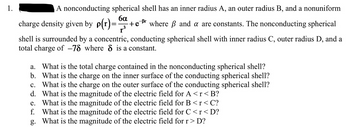A nonconducting spherical shell has an inner radius A, an outer radius B, and a nonuniform charge density given by p(r)= 0 +e+ where ß and a are constants. The nonconducting spherical -Br σα r³ shell is surrounded by a concentric, conducting spherical shell with inner radius C, outer radius D, and a total charge of -78 where 8 is a constant. a. What is the total charge contained in the nonconducting spherical shell? b. What is the charge on the inner surface of the conducting spherical shell? c. What is the charge on the outer surface of the conducting spherical shell? WI. fl D2
A nonconducting spherical shell has an inner radius A, an outer radius B, and a nonuniform charge density given by p(r)= 0 +e+ where ß and a are constants. The nonconducting spherical -Br σα r³ shell is surrounded by a concentric, conducting spherical shell with inner radius C, outer radius D, and a total charge of -78 where 8 is a constant. a. What is the total charge contained in the nonconducting spherical shell? b. What is the charge on the inner surface of the conducting spherical shell? c. What is the charge on the outer surface of the conducting spherical shell? WI. fl D2
Related questions
Question
100%
Please answer part A,B,C. I posted it before but the answer was wrong and pleaase Do not copy the other's person works. Post all of your work In pictures. Thank you for your help!

Transcribed Image Text:1.
A nonconducting spherical shell has an inner radius A, an outer radius B, and a nonuniform
6α
charge density given by p(r)= +er where ß and a are constants. The nonconducting spherical
3
r³
shell is surrounded by a concentric, conducting spherical shell with inner radius C, outer radius D, and a
total charge of -78 where 8 is a constant.
b.
c.
a. What is the total charge contained in the nonconducting spherical shell?
What is the charge on the inner surface of the conducting spherical shell?
What is the charge on the outer surface of the conducting spherical shell?
What is the magnitude of the electric field for A<r<B?
e. What is the magnitude of the electric field for B <r<C?
What is the magnitude of the electric field for C<r<D?
g. What is the magnitude of the electric field for r > D?
d.
f.
Expert Solution
This question has been solved!
Explore an expertly crafted, step-by-step solution for a thorough understanding of key concepts.
Step by step
Solved in 5 steps with 8 images

Follow-up Questions
Read through expert solutions to related follow-up questions below.
Follow-up Question
Please answer part D,E,F,G show your answers in pictures please

Transcribed Image Text:1.
A nonconducting spherical shell has an inner radius A, an outer radius B, and a nonuniform
ба -Br
charge density given by p(r)= +e where ß and a are constants. The nonconducting spherical
shell is surrounded by a concentric, conducting spherical shell with inner radius C, outer radius D, and a
total charge of -78 where 8 is a constant.
a. What is the total charge contained in the nonconducting spherical shell?
b. What is the charge on the inner surface of the conducting spherical shell?
c. What is the charge on the outer surface of the conducting spherical shell?
d. What is the magnitude of the electric field for A<r<B?
e. What is the magnitude of the electric field for B<r<C?
f. What is the magnitude of the electric field for C<r<D?
g. What is the magnitude of the electric field for r > D?
Solution